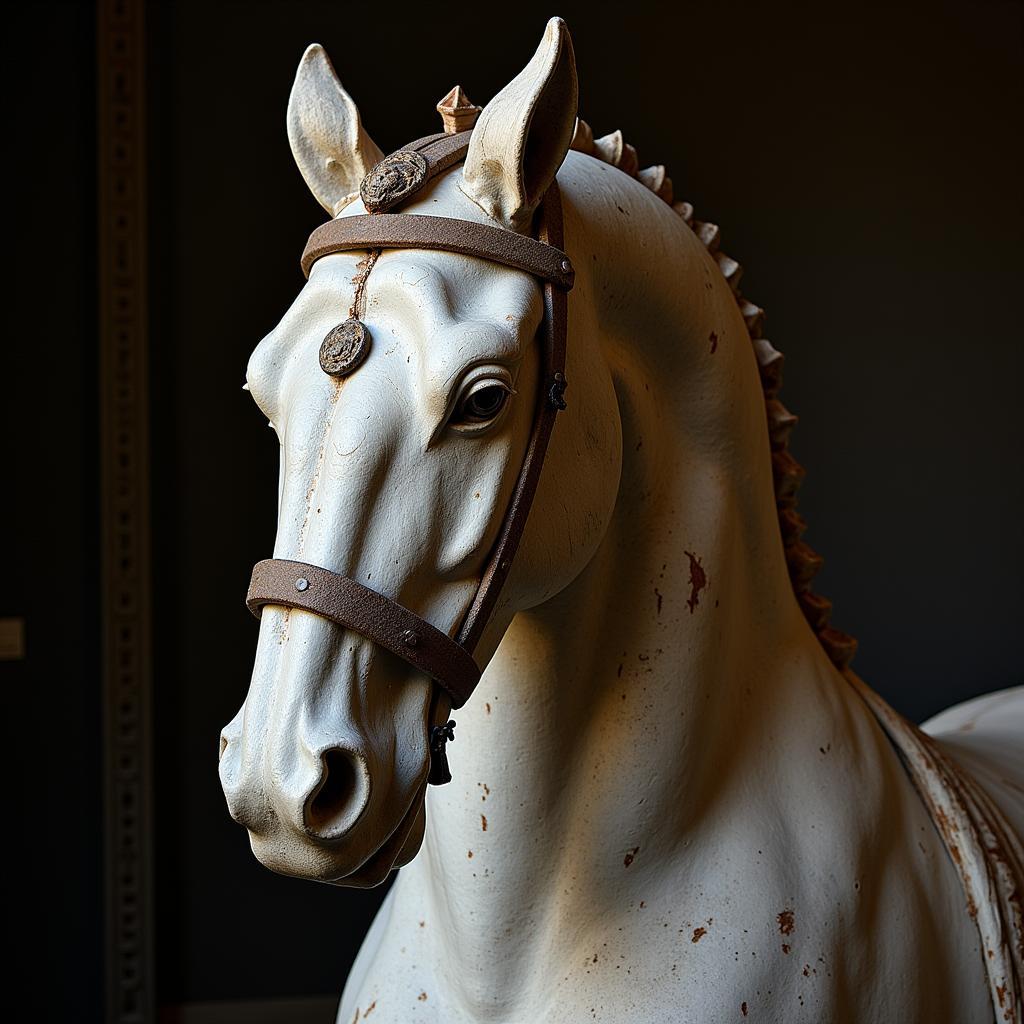The Medici Riccardi Horse Head, a fragmented Roman sculpture, embodies a fascinating intersection of history, art, and power. This remarkable piece, residing within the Palazzo Medici Riccardi in Florence, invites us to explore the Medici family’s appreciation for classical antiquity and their keen eye for collecting significant artifacts.
The Medici Riccardi Horse Head: A Glimpse into the Past
The horse head, believed to be a fragment of a larger equestrian statue, captures the raw power and elegance of the animal. Its weathered surface whispers tales of time, hinting at its Roman origins and the journey it undertook to reach the heart of Renaissance Florence.  Medici Riccardi Horse Head Sculpture in Florence
Medici Riccardi Horse Head Sculpture in Florence
A Symbol of Medici Power and Patronage
The Medici family, renowned for their political influence and patronage of the arts, carefully curated their collections to reflect their status and values. Acquiring the Medici Riccardi horse head was not merely an aesthetic choice; it was a statement of power, linking the family to the grandeur of the Roman Empire. This act resonated deeply within the context of Renaissance Florence, where the revival of classical ideals was a driving force. The horse head served as a tangible representation of this cultural shift, embodying the Medici family’s commitment to the rediscovery and preservation of the past.
Donatello, a prominent Renaissance sculptor, was deeply inspired by the Medici Riccardi horse head. His own equestrian statue of Gattamelata, a Venetian condottiero, bears a striking resemblance to the Roman fragment, demonstrating the influence of classical art on Renaissance masters.  Donatello's Gattamelata: Influence of Medici Riccardi Horse Head
Donatello's Gattamelata: Influence of Medici Riccardi Horse Head
Conserving a Legacy: The Medici Riccardi Horse Head Today
Today, the Medici Riccardi horse head remains a significant piece within the Palazzo Medici Riccardi collection. Efforts to preserve this historical artifact ensure that future generations can appreciate its beauty and historical significance. The ongoing research surrounding the horse head continues to unravel mysteries about its origins and the larger context of Roman sculpture.
Why is the Medici Riccardi Horse Head Important?
The horse head serves as a powerful reminder of the Medici family’s influence and their role in shaping the cultural landscape of Renaissance Florence. It symbolizes their connection to the past and their commitment to artistic patronage. The fragmented nature of the sculpture also speaks to the passage of time and the enduring power of art to transcend generations.  Medici Riccardi Palace: Home to the Horse Head Sculpture
Medici Riccardi Palace: Home to the Horse Head Sculpture
Conclusion
The Medici Riccardi horse head stands as a testament to the enduring legacy of Roman art and its impact on the Renaissance. It offers a unique window into the Medici family’s world, reflecting their power, artistic taste, and appreciation for the classical past. This fragmented sculpture continues to inspire awe and fascination, inviting us to explore the rich tapestry of history and art woven within its weathered surface.
FAQ
- What is the Medici Riccardi horse head? A fragmented Roman sculpture, believed to be part of a larger equestrian statue, housed in the Palazzo Medici Riccardi in Florence.
- Who were the Medici? A powerful and influential family in Florence during the Renaissance, known for their political power and artistic patronage.
- Why is the horse head significant? It symbolizes the Medici’s power, their connection to Roman antiquity, and their influence on Renaissance art.
- Where is the horse head located? In the Palazzo Medici Riccardi in Florence, Italy.
- How did the Medici acquire the horse head? The exact circumstances are unknown, but it reflects their interest in collecting classical antiquities.
- Did the horse head influence Renaissance artists? Yes, notably Donatello, whose Gattamelata statue shows similarities to the horse head.
- Is the horse head still on display? Yes, it remains a key piece in the Palazzo Medici Riccardi collection.
Need assistance? Contact us at Phone Number: 0772127271, Email: [email protected] Or visit us at QGM2+WX2, Vị Trung, Vị Thuỷ, Hậu Giang, Việt Nam. We have a 24/7 customer support team.